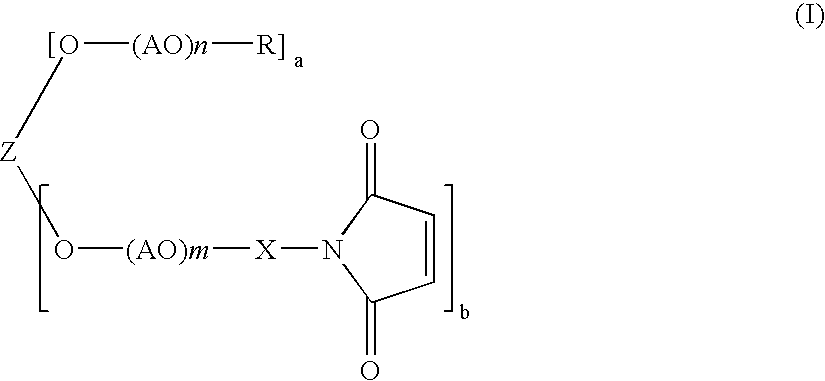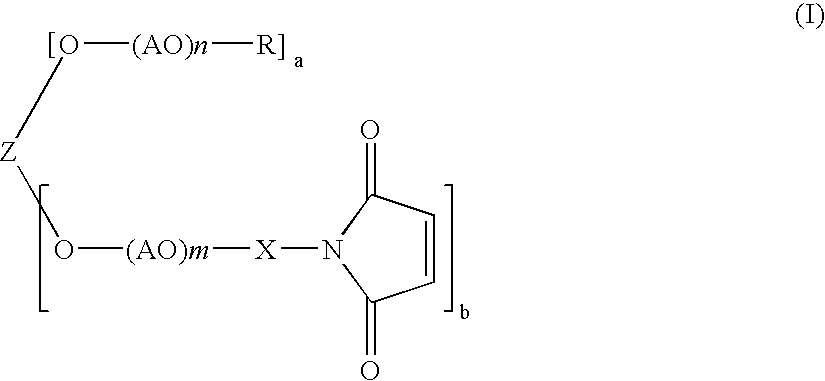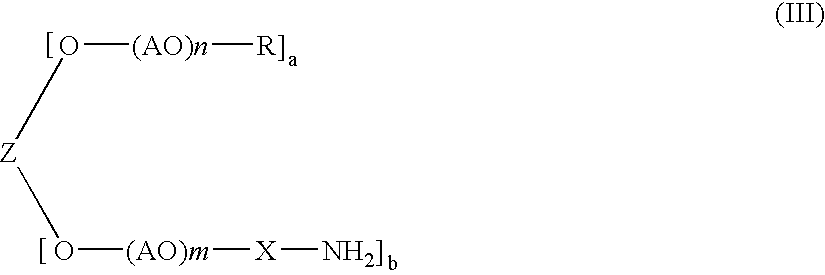Polyoxyalkylene derivative and process of producing the same
a technology of polyoxyalkylene and process, applied in the direction of medical preparations, non-active ingredients of pharmaceuticals, etc., can solve the problem that the reported process cannot be seen as suitable for industrial production, and achieve the effects of high purity, excellent storage stability, and useful modification of biological substances
- Summary
- Abstract
- Description
- Claims
- Application Information
AI Technical Summary
Benefits of technology
Problems solved by technology
Method used
Image
Examples
example 1
In a 3 liter four-necked flask equipped with a stirrer, a dropping funnel, a thermometer, and a nitrogen-bubbling tube was put 640 g of methoxypolyoxyethylene of formula (II) in which n+m=112, a=1, and b=1 (MEH-50H, available from NOF Corp.), and 640 g of ion-exchanged water was added to dissolve the compound. The solution was cooled to 10° C. or lower, and 40 g of 50% potassium hydroxide was added thereto. The solution was further cooled to 5° C. or lower, and 340 g of acrylonitrile was added thereto dropwise over 2 hours while keeping the liquid temperature to 5° C. or lower. After the addition, the stirring was continued for an additional 2 hour period. After completion of the reaction, the reaction mixture was neutralized by addition of 24 g of 85% phosphoric acid. To 842 g of the reaction mixture was added a solution of 500 g of sodium chloride in 2800 g of ion-exchanged water, and the mixture was extracted with 1000 ml of chloroform. The chloroform layer was separate...
example 2
In a 5 liter four-necked flask equipped with a stirrer, a dropping funnel, a thermometer, and a nitrogen-bubbling tube was put 1600 g of polyethylene glycol of formula (II) in which a=0, m=113, and b=2 (PEG 11000, available from NOF Corp.; molecular weight: 10000), and 1600 g of ion-exchanged water was added to dissolve the compound. The solution was cooled to 10° C. or lower, and 100 g of 50% potassium hydroxide was added thereto. The solution was further cooled to 5° C. or lower, and 850 g of acrylonitrile was added thereto dropwise over 2 hours while keeping the liquid temperature at 5° C. or lower. After the addition, the stirring was continued for an additional 2 hour period. After completion of the reaction, the reaction mixture was neutralized by addition of 60 g of 85% phosphoric acid. The reaction mixture was worked up in the same manner as in Example 1 by using a solution of 1250 g of sodium chloride in 7000 g of ion-exchanged water, 2500 ml of chloroform, and 12...
example 3
In a 5 liter four-necked flask equipped with a stirrer, a dropping funnel, a thermometer, and a nitrogen-bubbling tube was put 1600 g of tetra(polyoxyethylene) diglycerol ether of formula (II) in which a=0, m=56, and b=4 (DGE-10000, available from NOF Corp.; molecular weight: 10000), and 1600 g of ion-exchanged water was added to dissolve the compound. The solution was cooled to 10° C. or lower, and 100 g of 50% potassium hydroxide was added thereto. The solution was further cooled to 5° C. or lower, and 850 g of acrylonitrile was added thereto dropwise over 2 hours while keeping the liquid temperature at 5° C. or lower. After the addition, the stirring was continued for an additional 2 hour period. After completion of the reaction, the reaction mixture was neutralized by addition of 60 g of 85% phosphoric acid. The reaction mixture was worked up in the same manner as in Example 1 by using a solution of 1250 g of sodium chloride in 7000 g of ion exchanged water, 2500 ml of...
PUM
| Property | Measurement | Unit |
|---|---|---|
| Temperature | aaaaa | aaaaa |
| Temperature | aaaaa | aaaaa |
| Fraction | aaaaa | aaaaa |
Abstract
Description
Claims
Application Information
 Login to View More
Login to View More - R&D
- Intellectual Property
- Life Sciences
- Materials
- Tech Scout
- Unparalleled Data Quality
- Higher Quality Content
- 60% Fewer Hallucinations
Browse by: Latest US Patents, China's latest patents, Technical Efficacy Thesaurus, Application Domain, Technology Topic, Popular Technical Reports.
© 2025 PatSnap. All rights reserved.Legal|Privacy policy|Modern Slavery Act Transparency Statement|Sitemap|About US| Contact US: help@patsnap.com



